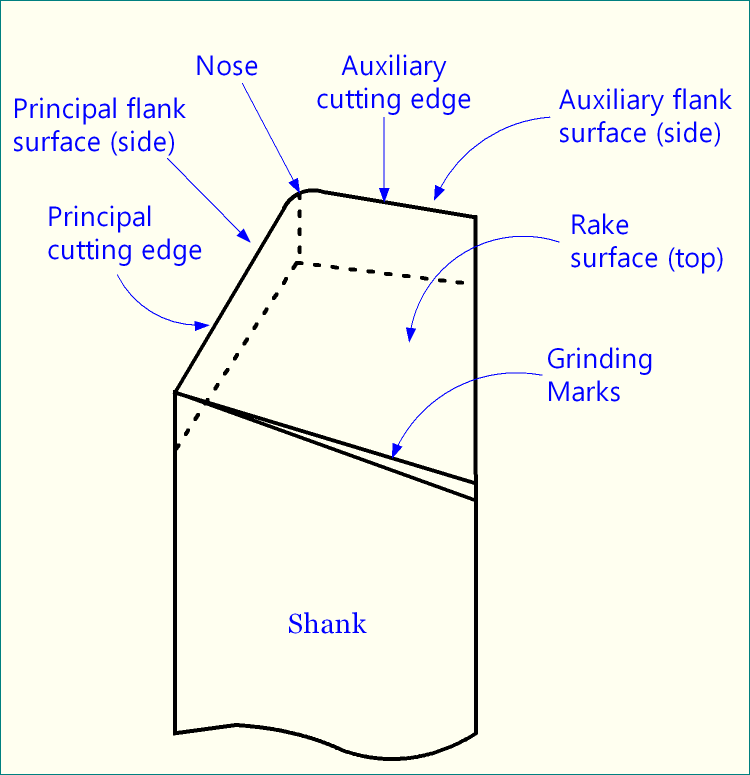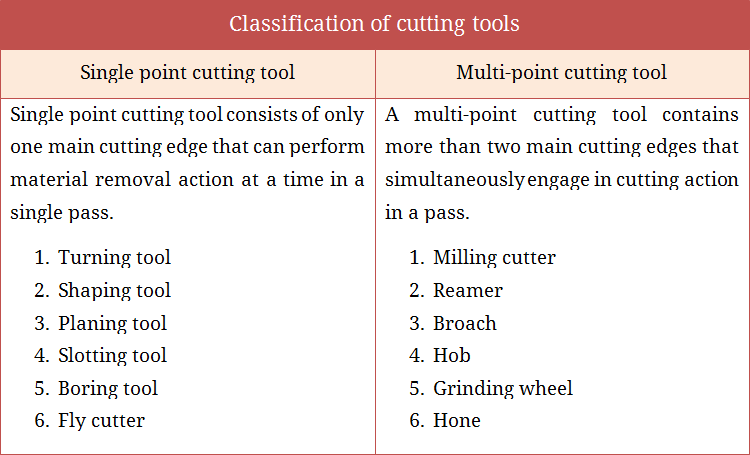Cutting edge is the intersection of two tool point surfaces. Cutting Tool is basically a wedge shaped device that actually removes (shears off) excess material from a preformed blank in order to obtain desired shape, size and accuracy. During machining or metal cutting operation, the cutting tool forcefully compresses a thin layer of material of the workpiece and shears it off.
Every cutting tool consists of at least two surfaces, namely, rake surface and flank surface. Rake surface is the chip flowing surface; whereas, flank surface slides over the finished surface of the workpiece. Intersection of these surfaces produces cutting edge.
Functions of cutting edge in machining
As the name suggests, the primary function of the cutting edge is to cut or shear off material in order to fulfill ultimate objective of machining. However, all cutting edges may not equally participate in cutting action. For example, in a turning tool, principal cutting edge usually removes material, whereas auxiliary cutting edge partially removes material only in some specific operations. In fact, a turning tool has two different cutting edges, as provided below.
- Principal cutting edge—The intersection between rake surface and principal flank surface produce principal cutting edge. This cutting edge cuts material during machining.
- Auxiliary cutting edge—It occurs at the intersection of rake surface and auxiliary flank surface. It can also perform cutting action in some specific type of operations, such as thread cutting.

Does the cutting edge always straight?
The cutting edge may or may not be a straight line. For example, for a single point turning tool (SPTT), the cutting edges are straight. Similarly, in milling cutter and drill, it is usually straight. However, if you consider abrasive cutters, it may not necessarily straight.
How sharp a cutting edge is?
Can you directly measure sharpness?—No! The sharpness of any physical object is indicated by edge radius and they are inversely proportional. That means, the small is the edge radius, the sharper it is. Therefore, theoretically, the maximum sharpness or minimum edge radius is limited to atomic radius of the material. You cannot go below it.
Although atom radius is too small (few nm), in high precision cutting tools, the cutting edges are sharp in that range. Edge radius of precision turning diamond cutter is 10 – 100nm, while that for micro-end mills is 1 – 5µm. However, in convention turning, milling, drilling, etc. cutters, the edge radius usually much higher, around tens of microns. It is worth mentioning that sharper tools need lesser cutting power for material removal but are very prone to catastrophic breakage.
Single point, double point and multi-point cutting tools
A cutting tool may have one or more cutting edges, and therefore, it can be classified into three categories—single point, double point and multi-point cutting tools.

Single point cutting tools—These tools consist of only one cutting edge that can perform metal removal action at a time. Turning tool is the perfect example of a single point tool. Shaping, planing, slotting, boring tools are also single point tool.
Double point cutting tools—These tools have two cutting edges and both the edges can perform material removal action simultaneously. Drill is the only example for this category.
Multi-point cutting tools—As the name suggests, these tools have more than two cutting edges. The number of cutting edges present in a cutting tool may vary from around four (in milling cutter) to hundreds (in grinding wheel). However, all cutting edges may not perform cutting action simultaneously; they can successively engage and disengage. Examples include milling cutters, hobs, broaching tools, grinding wheels, etc. Read: Difference between single point and multi-point cutting tool.
References
- Book: Principles of Mechanical Engineering by S. Singh (S. Shand).
- Book: Machining and Machine Tools by A. B. Chattopadhyay (Wiley).
- Book: Metal Cutting: Theory And Practice by A. Bhattacharya (New Central Book Agency).
- Book: Manufacturing Processes by J. P. Kaushish (PHI).
- Book: Manufacturing Science by M. I. Haque and S. Khan (PHI).